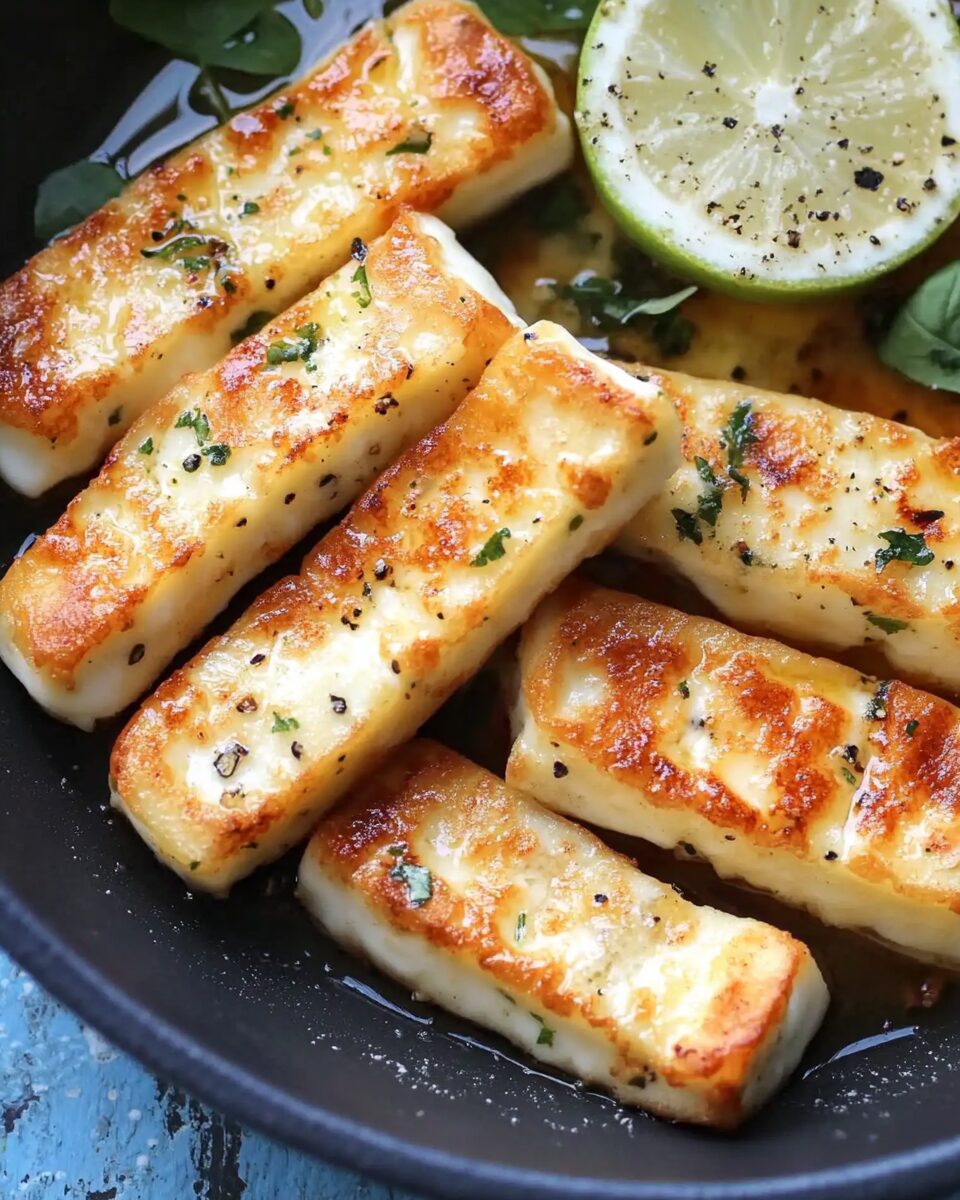Halloumi Cheese Fingers are a delightful appetizer originating from Cyprus, featuring the unique, semi-hard cheese known as halloumi. Renowned for its high melting point, halloumi can be fried or grilled without losing its shape, resulting in a crispy exterior and a warm, chewy interior. These cheese fingers are quick to prepare and offer a savory, slightly salty flavor, making them a popular choice for gatherings and casual snacking.
Full Recipe:
Ingredients
- ½ tablespoon olive oil
- 6 ounces halloumi cheese, cut into ½-inch thick sticks
- 2 teaspoons fresh lemon juice
- ¼ teaspoon dried oregano
- Black pepper to taste
Directions
- Heat the Oil: In a skillet over medium heat, warm the olive oil.
- Cook the Halloumi: Add the halloumi sticks to the skillet and cook until they turn light golden brown, approximately 1 to 2 minutes per side.
- Season and Serve: Remove from heat and sprinkle with fresh lemon juice, dried oregano, and black pepper. Serve immediately.
Nutritional Facts (Per Serving)
- Calories: 299
- Total Fat: 25g
- Saturated Fat: 13g
- Cholesterol: 64mg
- Sodium: 936mg
- Total Carbohydrates: 3g
- Dietary Fiber: 0g
- Sugars: 0g
- Protein: 18g
The History and Origin of Halloumi Cheese
Halloumi cheese has been a staple in Mediterranean cuisine for centuries, particularly in Cyprus, where it is believed to have originated over 1,500 years ago. Traditionally made from sheep’s and goat’s milk, modern variations sometimes include cow’s milk. Halloumi was historically produced as a way to preserve milk, with its brined nature allowing it to be stored for extended periods.
Over time, halloumi gained popularity beyond Cyprus and is now enjoyed worldwide. Its firm texture and salty, slightly tangy taste make it a favorite ingredient in various dishes, from salads and sandwiches to grilled appetizers and fried cheese bites.
Why Halloumi Cheese is Special
Unlike most cheeses that melt when exposed to heat, halloumi retains its structure due to its unique protein composition. This makes it ideal for frying, grilling, and baking. Other reasons why halloumi stands out include:
- Firm, Chewy Texture – The cheese has a dense, springy bite, making it different from soft cheeses like mozzarella.
- Mildly Salty and Tangy Flavor – Halloumi is brined during production, giving it a naturally salty taste that pairs well with fresh and acidic ingredients.
- Versatility in Cooking – Whether grilled, pan-fried, or baked, halloumi adapts well to different cooking methods.
- High-Protein Content – Halloumi is a great source of protein, making it an excellent option for vegetarians looking to add more protein to their diet.
Why You’ll Love Halloumi Cheese Fingers
- Crispy on the Outside, Soft on the Inside – The contrast in textures makes every bite satisfying.
- Quick and Easy to Prepare – Requires minimal ingredients and cooking time.
- Perfect as an Appetizer or Side Dish – Great for entertaining guests or complementing a main meal.
- Packs a Flavor Punch – Salty, slightly tangy, and incredibly delicious.
- Pairs Well with Many Dipping Sauces – Can be served with a variety of sauces to enhance its flavor.
Best Ways to Serve Halloumi Cheese Fingers
Halloumi cheese fingers are incredibly versatile and can be served in several ways, depending on the occasion and personal preferences:
- As an Appetizer: Serve with lemon wedges, fresh herbs, and a dipping sauce for a simple yet flavorful starter.
- With a Side Salad: Pair with a fresh Mediterranean salad featuring tomatoes, cucumbers, and olives for a balanced dish.
- In a Sandwich or Wrap: Use halloumi cheese fingers as a filling in pita bread or wraps along with veggies and a tangy sauce.
- With Grilled Vegetables: Serve alongside roasted bell peppers, zucchini, or eggplant for a well-rounded meal.
- On a Mezze Platter: Add to a spread of hummus, olives, tzatziki, and pita bread for a Middle Eastern-inspired feast.
Dipping Sauces to Pair with Halloumi Cheese Fingers
Halloumi cheese fingers taste fantastic on their own, but dipping sauces can take them to the next level. Here are some great sauce options:
- Tzatziki Sauce – A cool and creamy yogurt-based sauce with cucumber and garlic.
- Spicy Harissa Mayo – A blend of mayonnaise and harissa paste for a spicy kick.
- Honey Mustard – A sweet and tangy combination that balances the saltiness of the cheese.
- Garlic Aioli – A rich, garlicky sauce that enhances the crispy texture of the halloumi.
- Sweet Chili Sauce – A mildly spicy and slightly sweet dip that adds an extra layer of flavor.
Tips for Making the Best Halloumi Cheese Fingers
To ensure that your halloumi cheese fingers turn out crispy and full of flavor, follow these expert tips:
- Use a Non-Stick Pan or Grill – This prevents the cheese from sticking and ensures even browning.
- Do Not Overcook – Halloumi cooks quickly; frying for just 1-2 minutes per side is enough to achieve a golden crust.
- Cut Even-Sized Pieces – Uniform sizes ensure that all cheese fingers cook evenly.
- Serve Immediately – Halloumi is best enjoyed hot while it retains its crispy texture.
- Pair with Fresh Ingredients – Fresh herbs, lemon juice, and tomatoes complement the salty flavor of halloumi beautifully.
Variations to Try
While classic halloumi cheese fingers are delicious on their own, you can experiment with different flavors and cooking methods:
- Spiced Halloumi Cheese Fingers – Sprinkle paprika, cumin, or chili flakes for extra heat and flavor.
- Breaded Halloumi Fingers – Coat in breadcrumbs before frying for an extra crispy texture.
- Grilled Halloumi Fingers – Instead of frying, grill the cheese for a smoky taste.
- Baked Halloumi Fingers – For a healthier version, bake them in the oven until golden brown.
How to Store and Reheat Halloumi Cheese Fingers
Halloumi cheese fingers are best enjoyed fresh, but if you have leftovers, they can be stored and reheated as follows:
- Refrigeration: Store in an airtight container for up to 3 days.
- Freezing: Not recommended, as halloumi may change texture when thawed.
- Reheating: To regain crispiness, reheat in a pan over medium heat for a few minutes or use an air fryer. Avoid microwaving, as it can make the cheese rubbery.
Frequently Asked Questions
1. Can I make halloumi cheese fingers without frying?
Yes! You can grill or bake them instead for a healthier alternative.
2. Can I use different types of cheese?
Halloumi is the best choice due to its high melting point, but paneer is a good alternative.
3. Why is my halloumi rubbery?
Overcooking can make halloumi tough. Cook it just until golden brown to maintain the best texture.
4. Can I marinate halloumi before cooking?
Yes! Marinating in olive oil, lemon juice, and herbs can enhance its flavor.
5. Is halloumi vegetarian?
Traditional halloumi is made with animal rennet, but vegetarian versions are available.
Conclusion
Halloumi cheese fingers are a simple yet indulgent dish that highlights the rich, salty flavors and unique texture of halloumi cheese. Whether served as an appetizer, snack, or part of a mezze platter, they are guaranteed to be a crowd-pleaser.






